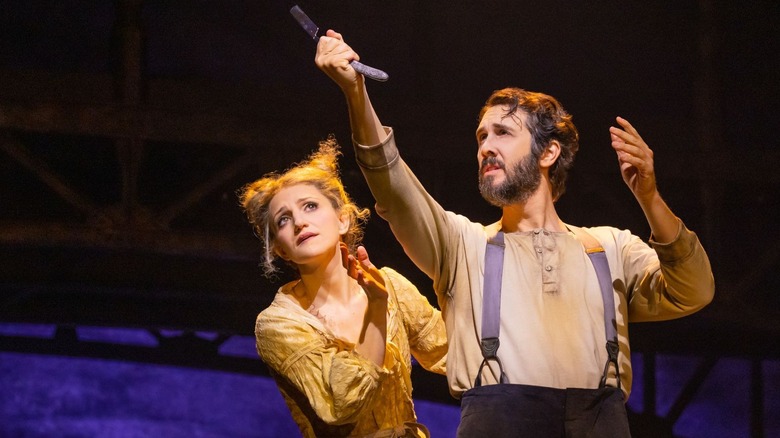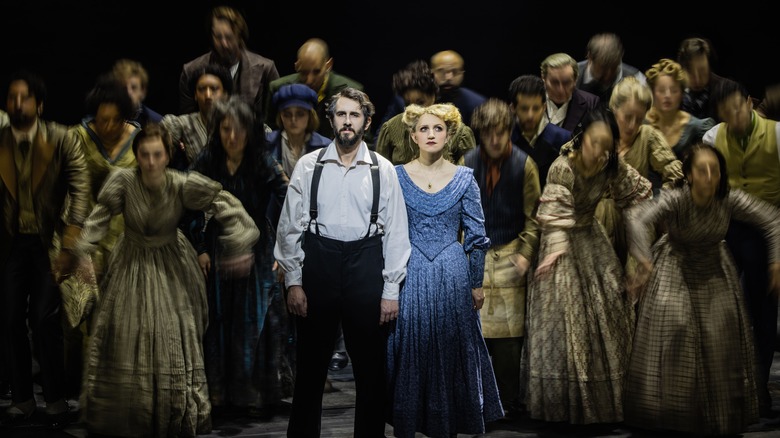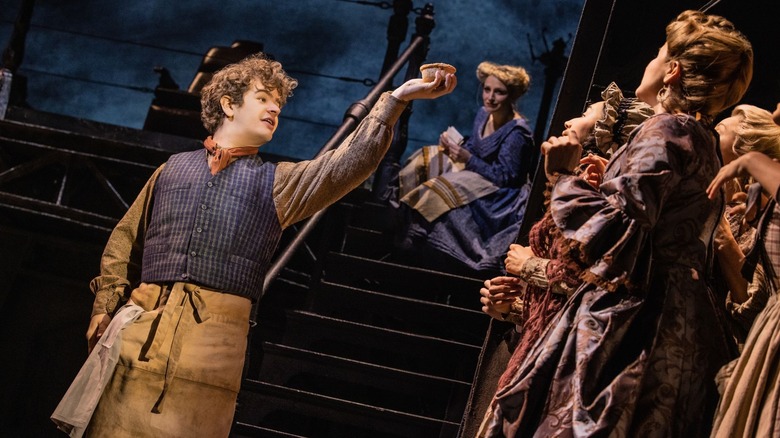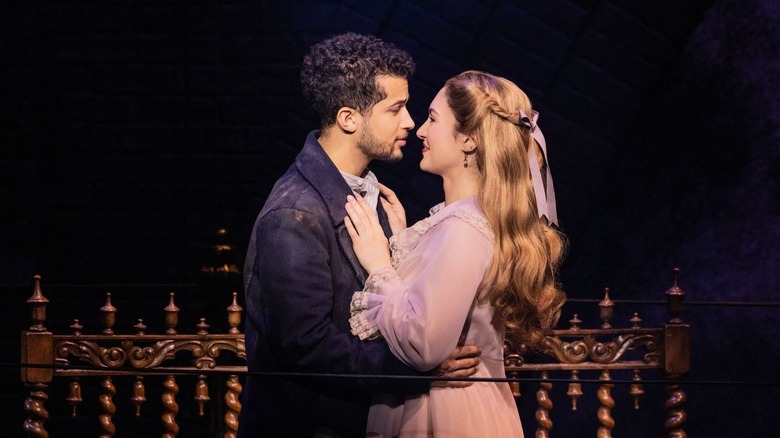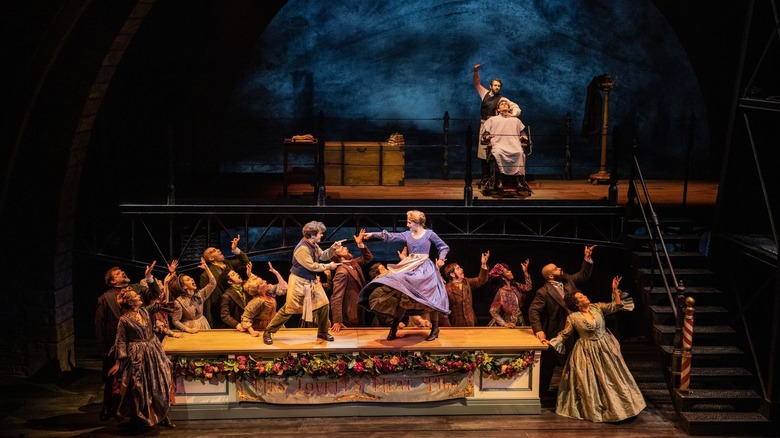Sweeney Todd Broadway Review: A Perversely Beautiful Sondheim Murder Musical
The power of "Sweeney Todd" lies in its ability to seduce its audience to stare (and chortle) at the ingenuity of murderous cannibalism. Since its 1979 opening on Broadway (starring Len Cariou and Angela Lansbury), the darkly comic "Sweeney Todd: The Demon Barber Of Fleet Street" has been a general favorite of Stephen Sondheim's musicals (depending on who you ask). It exists at the intersection of traditional musical theatre and operetta, permitting a flexible theatricality from the small-scale (John Doyle's 2005 version and the 2017 Barrow Street immersive pie shop staging) to the grandiose opera stage. In the hands of "Hamilton" director Thomas Kail, "Sweeney Todd" stays true to its theatrical technicalities on the Broadway stage for the most part.
Inspired by the 1840s penny dreadful serial and Christopher Bond's 1973 stage retelling, Hugh Wheeler's book deals with injustice in 19th-century London. "Sweeney Todd" follows the eponymous barber who returns to the capital to start life anew as a barber after his imprisonment for a trumped-up charge. 15 years after his incarceration, he discovers that his condemner, the corrupt Judge Turpin (Jamie Jackson), has stolen his wife and daughter. Outraged, this realization catalyzes his bloodthirsty quest to slash the throats of unsuspecting customers with the assistance of the pie shopkeeper Mrs. Lovett (Annaleigh Ashford) below his barbershop. She hatches a brilliant and economical scheme to churn Sweeney's barber victims into meat pies that court the Londoners' tastebuds. Meanwhile, Todd's sailor acquaintance, Anthony (Jordan Fisher), happens to fall for Sweeney's stolen daughter, Johanna (Maria Bilbao), and the two plot to escape Judge Turpin's clutches.
No place like London
With the hype of Jonathan Tunick's resurrection of the 26-player orchestration in a sunken pit setup, Kail guides this revival with musical supervision by Alex Lacamoire. Mimi Lien's scenic design frames 19th-century London in a tunnel-like arch and loads the mise-en-scène with the necessary furniture: baking counters, tables, chests, signs, platforms, and a giant furnace. The second story suggests a London bridge that doubles as Sweeney's workspace. This revival may not be the scenic maximalist dream for theatergoers, but lighting designer Natasha Katz choreographs the lightning and color tints around bareness.
In more questionable creative choices, Steven Hoggett's choreography colors the storytelling with swinging motions and frantic twirls that dutifully fill the darkness, though it does end up repeating movements at the finale. One grandiose eyesore is a towering crane with a dangling hook that plays an important role in delivering the centerpiece chair of Sweeney's murder plot.
The gears are whirling
Shouldering the meaty murderous role, Josh Groban performs the task well (after a recent stint in the Beast mecha puppet in the "Beauty and the Beast: A 30th Celebration"). His Sweeney suggests a defeated human who phased out his paternal affection and moral compass eons ago. Though experienced as Pierre from "The Comet of 1812" stage musical, the Groban and his vocals do come with baggage. The multi-platinum singer can be too attached to his angelic gloss. It works when he pines ("Johanna – Quartet" and "Pretty Women") and the beauty creates ironic friction between his macabre acts, but it's not as effective in his conversational scheming ("God! That's Good"). For a moment, he accomplishes his full-throttle comic callousness in "A Little Priest."
A good Groban is outmatched by Annaleigh Ashford, who has the large shoes to fill for Lovett's originator, the late Angela Lansbury. Starting with "The Worse Pies in London," she cinches the physical timing with the batter clawing, flour spatting, and spitting. Leaving no line nor lyric unsculpted, she makes a meal out of Lovett's voraciousness. Much of the hilarity comes from her stolen one-sided nuzzles with him. Out of all the corpse meat sliding from his barber chair, Todd is the flesh that she covets the most. But most importantly, her bouts of buttery warmheartedness grind with her duplicity. She's a paragon of that human complexity found in Sondheim's works.
Major players
Sadly, the weakest casting choice turned out to be Jordan Fisher as the affable Anthony, disinteresting but convincingly wholesome. A role that pairs Fisher's pop-rock sensibilities with Bilbao's pristine soprano exacerbates his cumbersome task. When Anthony's lyrics are supposed to balm Johanna's anxiety, his "Kiss Me"! crumble rather than comfort. As for Bilbao, she can play the well-trained demure doll in front of her forced adoptive predatory patriarch while also rattling with survival instincts. Also a survivor is Gaten Matarazzo's Toby. Armed with a polished voice since his childhood Gavroche days on "Les Miserables," the 20-year-old "Stranger Things" star finds heartache in Toby, a browbeaten servant and then beloved (then betrayed) foster child of Lovett. Ingeniously, Matarazzo sees Toby's final fractured mutterings as not succumbing but a struggle to regain order and innocence after all the chaos.
The antagonists are also fun. Nicholas Christopher hams it up as Pirelli, a rival barber flaunting a fake Italian accent, who can barely contain panic beneath persnickety smugness. While Judge Turpin doesn't loom large enough as a threat, Jamie Jackson composes him with vulturish carnality. At Jackson's side, John Rapson ramps up the punchable gentility as the Judge's lackey, Beadle Bamford — who could perform a mean "Polly Plunkett."
Aside from an excellent ensemble, rounding out the cast is Ruthie Ann Mills as the raving Beggar Woman — whose lucidity bubbles out at sporadic beats. Yet, her omens underscore compassionate warnings that the players dismiss.
The Sondheim sound
Although supplied with orchestral sounds and qualified character interpretations as worthy spectacles, this is by no means a "Sweeney Todd" as visceral as its class ideas. On an operatic surface level, Wheeler's and Sondheim's textual themes of injustice, obsession, and carnal hypocrisy (done so well with the relationship between Lovett's compassionate tendencies and her atrocities) can quake the emotions. But this design seems disinterested in sculpting its themes — perhaps not as much as Hal Prince's original factory-like framing. Emilio Sosa and J. Jared Janas tailor their respective costume and makeup-hair work with serviceable distinctions, yet the wardrobe and faces often remain too indiscriminate and clean.
Kail crafts a passable directorial thesis: The clockwork of a revenge tale entices more than any social introspection frothing beneath its entertaining surface. From the opening to the finale, the chorus marvels at the proficiency and playfulness of Sweeney and Lovett's evils. "A Little Priest" impresses with its lyrical dexterity, just as the "God, That's Good!" sequence pieces together the mechanics of the murder. So its Brecthian insights like "who eats eaten and who gets to eat" land as borrowed smartness rather than hard-hitting commentary for both its internal London and the world the audience will return to outside the theatre. For those reasons, maybe that's why this "Sweeney Todd" is a safe and salivating crowdpleaser. Now, are you going to eat that pipping hot pie?
"Sweeney Todd" is playing on Broadway at the Lunt-Fontanne theatre.
